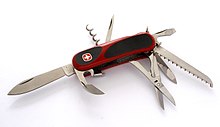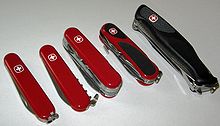Wenger
| Wenger SA
|
|
|---|---|
| legal form | Corporation |
| founding | 1893 |
| Seat |
Delémont Switzerland |
| Number of employees | 150 |
| Website | www.wenger.ch |
Wenger was a Swiss manufacturer of pocket knives and knives founded in 1893 , which was internationally known in particular as one of the two original manufacturers of the Swiss Army Knife . The company was taken over by competitor Victorinox in 2005 . Since 2013, Wenger has only been the brand name of a wristwatch line for women and men as well as a luggage and accessories series in the Victorinox range .
history
The company was founded in 1893 by Paul Boéchat under the name Paul Boéchat & Cie. founded. The seat was the municipality of Courtételle in the Swiss canton of Jura . In 1895 the company was bought by a group of investors and renamed Fabrique suisse de coutellerie SA ; 1900, after the merger with the Basler cutlery factory , in Swiss cutlery factory . At the same time, this year the company moved to the neighboring municipality of Delémont , which has remained the company's headquarters to this day.
In 1901 pocket knives were delivered to the Swiss Army for the first time . The company was named Wenger in 1907 when Théo Wenger , who had been director since 1898, bought the factory and renamed it Wenger & Co. In 1922 the company was given its current name Wenger SA
In 2001 Wenger began to decline economically, as the terrorist attacks on September 11, 2001 banned even small knives in aircraft hand luggage almost worldwide. Accordingly, the sale of such knives in “ duty-free shops” at airports was also discontinued, although they were an important source of sales for Swiss knives. Because of the resulting slump in profits, Wenger ran into financial difficulties. Competitor Victorinox experienced the same problems with a drop in profits of 30%, but was able to remain in the profit zone due to the higher total sales.
In 2005 Wenger faced bankruptcy and was taken over by Victorinox, the other original manufacturer of the Swiss Army Knife. According to Victorinox, one of the main reasons for this takeover was that Wenger would remain in federal hands, as a purchase by foreign investors would damage the reputation of the famous Swiss knife. Wenger was retained as an independent brand despite the takeover and retained its independence in terms of development, production and marketing of its products. Wenger and Victorinox continued to be competitors on the market.
In 2013 Victorinox announced that the Wenger brand would no longer be used for knives. Instead, all knives would be sold under the core brand Victorinox. The production site for Messer in Delémont would be retained. Parts of the previous knife collection would be continued as the Victorinox Delémont collection under the Victorinox company logo .
The wristwatch business at the Pruntrut production site, which has existed since 1988, will continue to operate under the Wenger brand. The range includes women's and men's wristwatches in the medium to low price structure. The same applies to licensed products such as suitcases, travel accessories and the like. The Wenger logo was retained on these products, which differs from the Victorinox logo in its almost square shape with rounded corners.
knife
The most important Wenger products were the Swiss knives - usually with red plastic handle scales - which when folded are 85 mm long. Wenger has been providing its knives with ergonomically shaped handles under the product name Evolution since 2004 ; the design came from the two Swiss designers Patrick Eppenberger and Paolo Fancelli ; however, the classic flat handle scales were still offered. There were also grips in other colors or made of other materials. Just like Victorinox, Wenger marked his pocket knives with the Swiss cross as a trademark. The two brands can be distinguished on the frame around this cross: Wenger uses a rectangular frame, Victorinox a coat of arms. The brand name is also embossed on the blade along with an implied crossbow . This is an allusion to the Swiss national hero Wilhelm Tell , who according to legend is a masterful crossbowman.
There are numerous variants of the Wenger Swiss knife. The simplest have only a sword and combi tool as a bottle opener , can opener and screwdriver functions. The most extensive knives, on the other hand, have several dozen functions. There are also knives that are intended for special target groups such as cyclists, golfers or anglers. In contrast to Victorinox, Wenger also offered some of its Swiss knives with a lockable backlock blade.
In addition to the 85 mm knives, there are also Swiss knives in other sizes. Smaller knives have a folded length of 65 mm, larger knives - offered under the names Ranger , NewRanger and RangerGrip - one of 127 mm. The blades of these larger knives can usually be locked using a liner lock system. Some models in the NewRanger and RangerGrip line can be opened with one hand, which means that the use of these knives in Germany is restricted according to Section 42a of the German Weapons Act .
With the Giant Knife 2007 , a 24 cm wide pocket knife equipped with 87 tools, offering 141 functions and weighing 1345 g, Wenger secured the entry for the world's largest pocket knife in the Guinness Book of Records .
In cooperation with various partners, Wenger has developed special versions of its Swiss knives on several occasions. From 1989 the company produced the " Official World Scout Knife " in cooperation with the World Scout Association , the World Organization of the Scout Movement . 2000 was Porsche design line published, which should remember with a special handles design to the sports car from Germany. In 2007 Wenger worked with the Swiss sailing team Alinghi to develop special knives for sailors based on the NewRanger line, which the crew of the Alinghi then also carried at the 32nd America's Cup in 2007. Also based on the NewRanger, a knife, available from 2009, was developed in collaboration with the adventurer and environmental activist Mike Horn .
Wenger sells kitchen knives for private use under the brand name Grand Maître , professional professional knives such as butcher knives under the name SWIBO . A traditional distinguishing feature of SWIBO knives is the bright yellow plastic handle. Later, other handle colors were also available.
In 2007, Wenger's daily production amounted to around 22,000 Swiss knives, 5,000 SWIBO knives and 1,000 Grand Maître knives.
Web links
Individual evidence
- ↑ Wenger.ch: History ( Memento of 31 May 2009 at the Internet Archive ). Retrieved May 24, 2009.
- ^ Leithold, R. ( Zeit Online , August 11, 2005): The third hand .
- ↑ Handelsblatt (April 26, 2005): Pocket knife manufacturer Victorinox buys Wenger .
- ^ Swissinfo.ch (April 26, 2005): Victorinox: Wedding after more than 100 years .
- ↑ a b Victorinox bundles strengths and integrates Wenger knife business. Victorinox, January 30, 2013, accessed December 3, 2014 .
- ↑ Ramona Krucker: Out for Wenger knives. Neue Zürcher Zeitung, January 31, 2013, accessed on December 3, 2014 .
- ↑ Wenger.ch: Scout ( Memento of 29 April 2010 at the Internet Archive ). Retrieved July 28, 2010
- ↑ Wenger.ch: Porsche Design ( Memento from April 27, 2010 in the Internet Archive ). Retrieved May 24, 2009
- ↑ Wenger.ch: Alinghi SUI1 ( Memento from July 24, 2010 in the Internet Archive ). Retrieved July 28, 2010
- ↑ Wenger.ch Mike Horn Knife ( memento from July 24, 2010 in the Internet Archive ). Retrieved July 28, 2010
- ↑ Wenger.ch (June 2007): Wenger History and BambooLine ( Memento of December 14, 2007 in the Internet Archive ). Retrieved May 25, 2009.




